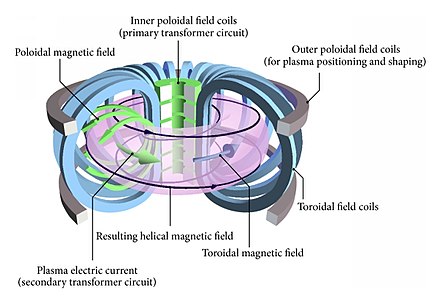Part 1 of 2 Parts
I have occasionally blogged about nuclear fusion as a possible energy source for the future. When the atoms of two light elements are brought together in a star, they fuse into a heavier element and release huge amounts of energy. If it is possible to replicate this process on Earth with human technology, it offers the prospect of virtually limitless clear energy with greater safety, lower cost and without the nuclear wastes produced by our current use of nuclear fission in nuclear power plants.
However, creating a miniature sun on Earth and confining it to a fusion reactor is not a simple task. In order to duplicate conditions found in the heart of a star, enormous pressures and extreme temperatures and extremely powerful magnetic fields are required. Currently, we don’t have materials that are able to survive these extreme conditions. However, progress is being made in the development of such materials.
There are many different designs for nuclear fusion reactors that employ different fuels. One of the most well-known general types of fusion reactors is called a tokamak. This is a Russian word which is an acronym for “toroidal chamber with magnetic coils” in Russian. The main chamber of a tokamak is donut-shaped. Inside the tokamak, isotopes of hydrogen named deuterium and tritium are heated until the electrons are stripped from the atoms and they become a charge gas called a plasma.
The fact the nuclear particles in a plasma are charged means that they can be trapped and compressed by a magnetic field. By design, the plasma is intended to stay in the middle of the donut-shaped tube and not touch the sides of the reactor.
When enough energy has been applied to the deuterium and tritium, they create helium, neutrons and a huge amount of energy. The plasma must be heated to temperatures of around two hundred million degrees Fahrenheit in order to trigger large amounts of fusion reactions. This temperature is ten times hotter than the center of our Sun. The reason that the temperature has to be so much hotter than the sun is that the density of the plasma in the Sun is much greater than it is in a tokamak.
Although the plasma in a tokamak is confined by the magnetic field, the materials the reactor is constructed from must be able to survive extreme temperatures. ITER is a huge prototype fusion reactor that is being constructed in France by an international consortium and is expected to be complete by 2035. The hottest part of the ITER is expected to reach twenty-four hundred degrees Fahrenheit.
While the extreme magnetic fields in a tokamak are intended to fully contain the plasma, sometimes the plasma might collide with the walls of the tokamak. This can cause erosion of the material in the walls, atoms of fuel can be embedded in the walls and there can be changes to the properties of the materials in the walls.
In addition to the extreme temperatures in a tokamak, there is also the problem of the byproducts of the fusion of deuterium and tritium. This consists of extremely high energy neutrons. Neutrons are neutral nuclear particles and so they cannot be confined by a magnetic field. This means that they hit the walls of the tokamak and cause damage.
Please read Part 2 next
Nuclear Fusion 120 – New Materials Need To Be Developed To Construct Nuclear Fusion Reactors – Part 1 of 2 Parts

Written by
in
